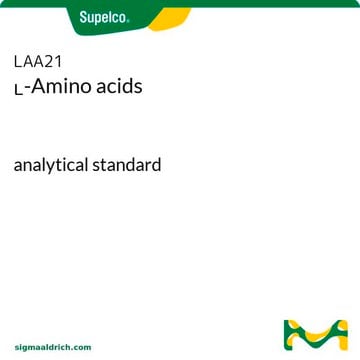75440
L-Ornithine dihydrochloride
≥99.0% (AT)
Synonym(s):
(S)-2,5-Diaminopentanoic acid dihydrochloride
About This Item
Recommended Products
Quality Level
Assay
≥99.0% (AT)
form
crystals
optical activity
[α]20/D +17±1°, c = 5% in H2O
technique(s)
ligand binding assay: suitable
ign. residue
≤0.1% (as SO4)
color
colorless
mp
197-199 °C (dec.)
anion traces
sulfate (SO42-): ≤100 mg/kg
cation traces
As: ≤0.1 mg/kg
Cd: ≤5 mg/kg
Co: ≤5 mg/kg
Cu: ≤5 mg/kg
Fe: ≤5 mg/kg
NH4+: ≤100 mg/kg
Ni: ≤5 mg/kg
Pb: ≤5 mg/kg
Zn: ≤5 mg/kg
SMILES string
Cl.Cl.NCCC[C@H](N)C(O)=O
InChI
1S/C5H12N2O2.2ClH/c6-3-1-2-4(7)5(8)9;;/h4H,1-3,6-7H2,(H,8,9);2*1H/t4-;;/m0../s1
InChI key
HGBAVEGDXFHRQP-FHNDMYTFSA-N
Biochem/physiol Actions
Storage Class Code
11 - Combustible Solids
WGK
WGK 3
Flash Point(F)
Not applicable
Flash Point(C)
Not applicable
Certificates of Analysis (COA)
Search for Certificates of Analysis (COA) by entering the products Lot/Batch Number. Lot and Batch Numbers can be found on a product’s label following the words ‘Lot’ or ‘Batch’.
Already Own This Product?
Find documentation for the products that you have recently purchased in the Document Library.
Customers Also Viewed
Our team of scientists has experience in all areas of research including Life Science, Material Science, Chemical Synthesis, Chromatography, Analytical and many others.
Contact Technical Service









